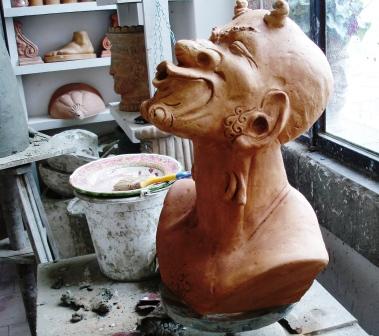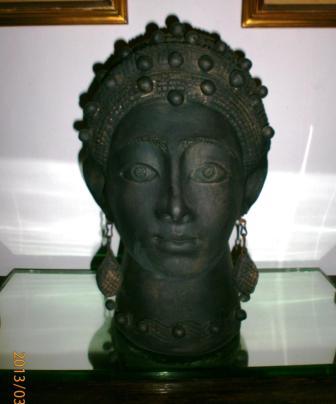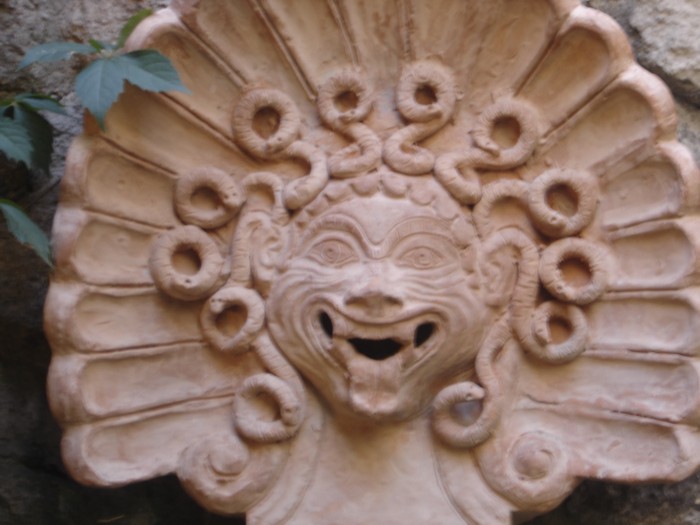
One morning a cryptic message flashed across my cell phone: “Have you met the Sphinx in Bolsena yet?”
The text was from a friend who owns a house near Italy’s secret jewel: Lake Bolsena, Europe’s largest volcanic lake and the spiritual hub of many cultures. For the Etruscans, this lake was the omphalos, the world navel, where once a year high priests congregated to perform rituals of renewal in the dense woods fringing its banks. The medieval pilgrim route to Rome, the Francigena, looped around its black, pebbled shores. In May each year in the village of Marta, pagan and Christian traditions interweave in the opulent blessing of the Fish. The dainty footsteps of a saint are pressed upon a miraculous stone beneath an altar in a lakeside church and an island out in the middle was once believed to be the portal to the underworld. With such a history behind it, I could surely believe sphinxes inhabited Bolsena, the town from which the lake takes its name, known in Etruscan times as Volsinii.
“Not yet,” I texted back. “How can I find her?” Sphinxes are, generally, feminine.
Her reply was puzzling. “Just follow the pot-heads to the castle.”
??Pot heads??
My friend, a genteel English lady of aristocratic bent, was probably unfamiliar with the associations that the word “Pot-Head” might have for someone growing up in the seventies. I wondered if perhaps she had made a typo and that “Pot heads” might be “Potter Heads” – referring perhaps to a book publicity event celebrating the magical escapades of H. Potter, who might have felt quite at home in Bolsena’ s labyrinthine, medieval streets.
Nevertheless, one cold spring day, we were intrigued enough to set out in search of the sphinx. The air was crisp, the lake unruffled indigo where chattering water birds floated and dived. We parked along an avenue fronted by pastel villas, shaded by stout linden trees and six-foot high hydrangeas. Once we had stepped through the gates into the old town, we immediately ran into the pot-heads. These were, literally, clay pots shaped like life-size heads whose faces recalled Etruscan gods and ancient Roman ladies, strung up all along the street, suspended by macramé ropes. In place of hair, scraggly ferns and ivy sprouted from the tops.
We followed the bobbing heads all the way up to the Etruscan museum , where a lusty, terracotta sphinx planter crouched at the bottom of a steep flight of steps. Upon enquiry, we learned that this remarkable creature had been made by a local artist who kept a shop on the main street. Finding the museum shut, we climbed back down to look for his shop, but that was closed as well. So we went off to lunch at Il Moro, a trattoria built over the water, where you have the illusion of being on a houseboat, and after a leisurely lunch of local fish, we wandered back to the shop, still shuttered tight. “You’ll probably find him in his studio,” advised the shopkeeper next door, explaining how to get there. We set off again in the direction of the castle, and when we came to a small yard strewn with terracotta sculptures, we knew we had arrived.

We rang the bell once, and after a long wait, the artist, looking as though he had just woken up from a nap, answered the door, and graciously invited us in. While he put on a pot of coffee, we sat down on worn leather chairs drawn up to a worktable spattered with daubs of dried clay. Row upon row of dusty heads – satyrs, goddesses, nymphs, gargoyles seemed to observe us as we sipped our espresso. I could very well imagine Mr. Utano carrying on long conversations with this army of heads. It occurred to me that when no one was there at night, all those heads chattering together probably made one hell of a noise.

That was our first trip of many trips to the shop and studio of Mr. Utano, whose fantastical creatures now fill my home and garden. Utano, a transported Sicilian who studied marble sculpture at the Carusi Workshop in Carrara, has also worked as a painter and restorer, and has even tried his hand at acting. His fanciful sculptures body forth from the dark pagan heart of Italy pulsing beneath Lake Bolsena, and from the sun-drenched, temples of Magna Graecia in his Sicilian homeland.
For an artist like Giuseppe Utano who fishes for iconic figures in the great sea of the unconscious, Bolsena and the surrounding areas of Tuscia and Maremma are a rich terrain for research. Etruscan tombs with their satyrs, mermaids, chimeras, and masks – gothic gargoyles and bestiaries, baroque sculpture gardens, like Villa Lante or Bomarzo, with their sculptural itineraries of enlightenment, alchemy, and transgression are situated within a short drive from here, as is one of the twentieth century’s greatest esoteric sculpture gardens, the Tarot Garden of Niki de Saint Phalle. There is just something in this myth-saturated landscape, in these mossy old stones blunted with time, that conjures beautiful monsters to the mind.

In baroque garden design, some scholars believe, the sculptures embodied human consciousness and emotion. Proper placement could alter fate, or transmit an epiphany or even ecstasy to visitors to the garden. Utano’s better pieces crackle with emotion, wit, and sensuality. Some smile benignly, while others snarl, howl, laugh, beguile you with a penetrating stare. Some chastely hold candles, others flaunt conical breasts, or ripple sexy mermaid tails. The bolder ones display Utano’s theatrical genius for the grotesque and the demonic, evoking that great spirit of gardens and nature, Pan. What must be remembered is that the energy irradiating from a work of art is conferred to matter by the artist’s hands — it’s that spark that gets lost in mechanical reproduction. Each of these pieces is unique and not mass produced in series. That’s what gives them their peculiar lifelikeness.

Placing gargoyles, masks, or monsters outside homes or sanctuaries was a way to warn intruders or the evil-intentioned. With that in mind, we commissioned Utano to make us a Gorgon to protect the gate of our private courtyard which we wished to shield from indiscreet gazes.
“Some people tell me they think this one is too ugly,” he said, pointing out a boyish satyr with a seraphic expression.

We couldn’t disagree more.


Mr. Utano’s shop is now called La Medusa. See the website for more information.
Copyright Linda Lappin, author of The Etruscan, Signatures in Stone: A Bomarzo Mystery, The Soul of Place: A Creative Writing Workbook, & Loving Modigliani: The Afterlife of Jeanne Hebuterne. Photo credits, L. Lappin, S. Baldassarre, G. Utano.






3 thoughts on “The Talking Heads of Giuseppe Utano in Bolsena”